The Hatsuharu-class destroyers (Hatsuharugata kuchikukan) were the next “special type” Imperial Japanese Navy destroyers in service in the interwar. The final two were heavily modified and considered separate as the Ariake class by some authors. In short, the Hatsurahu were built in answer to the 1930 London Treaty, which Japan signed (this was the last one). It was hard to hide the real value and size of the Fubuki class, so forbid Japan to continue cranking up it’s super destroyers capable of confidently taking on light cruisers, the overall destroyer tonnage for the IJN was capped at 105,500 tons with a maximal ship tonnage (standard) of 1,850 tons at 16% and the remainder would be below 1500 tonnes, meaning the Fubuki would remain a one-off serie. Undaunted, the IJN tried to work around an “austere” version which could officially match 1500t. This gave the Hatsuharu class, with 6 built. After many modifications, the next iteration would lead to the top heavy but better armed Shiratsuyu class. All were war losses; Nenohi was torpedoed by a US submarine, Hatsushomo was mined, and the remaining four were sunk by land or carrier-based aircraft. #IJN #imperialjapanesenavy #japanesenavy #ww2 #pacificwar #hatsuharu
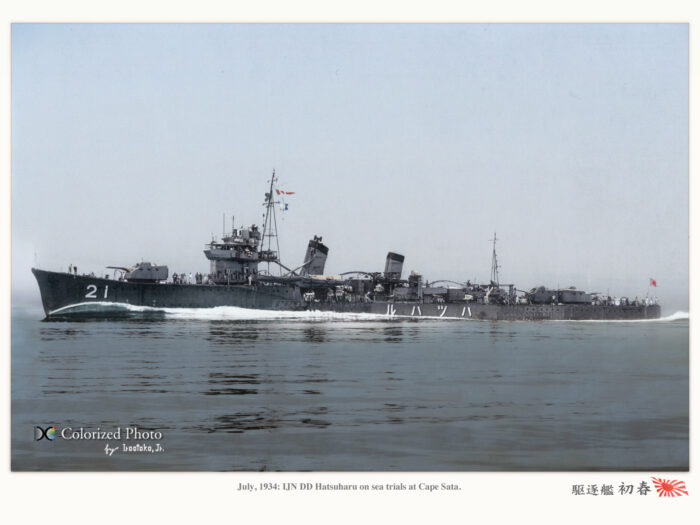
IJN Hatsuharu on trials, colorized by Irootoko JR.
Development
The Hatsuharu class, approved in the 1931 Programme, laid down 1931-33 and completed between September 1933 and March 1935, were designed for maximum performance on a displacement restricted by the 1930 London Treaty. The ships were smaller than the preceding classes, but had the same heavy TT armament and the added topweight of a superfiring 5in gun on the forecastle, so that stability was suspect; after the Tomozuru capsized, the Hatsuharu and Nenohi (the only units complete) were rebuilt, with one set of TT suppressed and the superfiring gun moved to upper deck level aft. The displacement rose to 1715t standard, 2066t trial, and speed fell to 33.3kts. The other ships in the class were modified similarly while building. Because of the torpedo reload arrangements, the second funnel was offset slightly to starboard of the centreline. With “X” turret removed in 1942-43, the armament became 4—Sin/50 DP (2×2), 13 to 21-25mm AA, 4-13.2mm AA, 36 DCs.
The provisions of 1930 London Naval Treaty enfirced severe limitations tht were overlooked by the Washington treaty on all nations, in the neglected category of destroyers and submarines as well as redfining cruisers. In particular this had immediate consequences for the Imperial Japanese Navy. She would be capped at 105,500 tons, 1,850 tons for 16% of her park (meaning the Fubuki-Akatsuki) and thus, 1,500 tons for the remainder tonnage. The Imperial Japanese Navy saw this as a severe blow, but ordered naval architects to design a new version of the “special type”, capped even 260 tons lower than the 1500t limit to try to regain and advantage in numbers on the global tonnage. And yet… mounting the same armament.
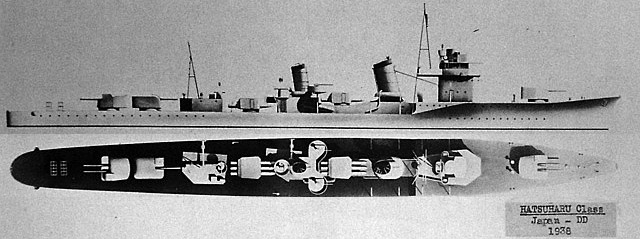
ONI depiction of the Hatsuharu class
This of course, proved totally unrealistic. In the, they still had two twin turrets but the third was swapped for a much lighter single shielded gun. Also there was no way around the short hull at a lower displacement, meaning no space for three tprpedo tubes banks. Only three triple were kept. Thus off arrangements was only shared at the time by the 1920s Romanian Mărăști and Mărășești.
However pushed hard by their orders, the architects produced a still over stretched, top heavy design, beyond all safety limits. These new shops would encounter early on severe stability problems, even far more than the already unstable Fubuki class, a curent theme in Japanese naval construction at the time.
Weight-control measures used by designers were also pushed to the extreme and compounded structural weakness. Of course when came the Tomozuru incident (A TB which capsized in 1934 in heavy sea), this already raised a red flag. This was further compounded in 1935 in the 4th fleet incident when a typhoon ripped the bows off two Fubuki-class destroyers. Like most of these ships, the navy decided to rebuilt the Hatsuharu-class ships, and in fact the first two, just completed were rebuilt twice. The others were modified during construction, which was underway when it happened. Several measures for strenghtening the hull and curtailing top structres, the addition of ballast, all toned down these stability problems. Still, the Hatsuharu class were left as the weakest of the whole “special type”, with little room for future upgrades.
In all, a dozen Hatsuharu-class destroyers were authorized in 1931 as part of the “Circle One Program” (Maru Ichi Keikaku). Three were laid down in FY1931 and the next three in FY1933. The remaining six ships however were rebuilt as the Shiratsuyu class and ended as a completely different design.
The Hatsuharu were built at the following yards:
Sasebo Naval Arsenal (2: Hatsuharu, Wakaba)
Uraga Dock Company (2: Nenohi, Hatsushimo)
Kawasaki-Kobe (1: Ariake*)
Maizuru Naval Arsenal (1: Yugure*)
*Both had significant differences and are considered sometimes as a sub-class.
Differences with the Fubuki class
They were considerable.
First off, the ships were much smaller, lighter, while still havng the same general hull design. Armament as said above was reduced, with a single gun under shield and two twin turrets instead of three, but still three triple TT banks (later in 1936, reduced to two). They still packed quite a punch, notably thanks to their new Type 90 and Tupe 93 “long lance” torpedoes without equivalent in the world. Engineers also mannaged to keep their speed as high as the Fubukis,
Rebuilding the Hatsuharu
On trials, Hatsuharu already started to roll heavily, and even at some point heeled at an angle of 38° at high speed on a turn about just 10°. For the frightened captain and staff this only meant engineers had to place the metacentric height way too low. In September 1933 it was ordered an immediate modification to alleviate the problem, with the addition of two 30-centimetre (12 in) wide bulges on each side below the waterline to increase beam, raise the metacentric height. Hatsuharu and Nenohi were the first modified after trials, but Wakaba and Hatsushimo were modified during construction whereas Ariake and Yugure at earlier stage just saw their beam increased by 1 metre (3.3 ft), and ended thus as a sub-class. The bulges were filled with concrete, adding 30 tonnes (30 long tons; 33 short tons) to the new trial displacement.
The Tomozuru incident of 1934 led to reevaluate the armament and more measures were taking to improve their stability:
- After deckhouse and rangefinder removed
- Forward single 12.7 cm gun relocated ahead of the after twin gun mount (magazine converted as fuel tank).
- No.3 triple torpedo mount and reload locker removed, not replaced.
- Compass bridge lowered by a level, and anti-strafing armor removed
- Funnels were shortened by 1–1.5 metres (3 ft 3 in – 4 ft 11 in) and masts.
- Forward torpedo tube mount lowered by 30 centimetres (12 in)
- Machine-gun platform lowered by 1.5 metres (4 ft 11 in)
- Searchlight platform lowered by 2 metres (6 ft 7 in)
- Bulges removed
- Anchor chain stowage lowered by one deck.
- Outer bottom plating reinforced
- 70 tonnes (69 long tons; 77 short tons) ballas added in the bottom.
- Automatic system in the fuel tanks to compensate by seawater what was consumed.
The first two were removed from service and modified at Kure Naval Arsenal along these lines while the remainder were were modified while still under construction, delaying their completion. In additon, Ariake and Yūgure received two balanced rudders directly behind the propellers, angled outward at 18.5° to reduce their heel when their rudder was turn. They lost one knot in to speed, combined with a beamier hull and shallower draft.
After the typhoon on 26 September 1935, the Hatsuharu returnd for 3 months in shipyards for radical hulls strengthening measure for a total of 54 tonnes (53 long tons; 60 short tons) while their bottom ballast went from 64 to 84 tonnes (63 to 83 long tons; 71 to 93 short tons). All this made them 23.2% heavier than initially planned back in 1932 traducing in a loss of 3 knots (5.6 km/h) down to 33, which was still valuable, but light loaded, and on perfect weather.
Design of the class
Hull and general design
The Hatsuharu-class ships were short at 109.5 m (359 ft 3 in) overall (versus 118.41 m so 9 meters less) for a beam of 10 metres (versus 10.4 meters) and at full load a draft of 3.35 m (11 ft), here again versus 3.2 m. Weight-saving measures in constriction still left them overweight, displacing 1,530 metric tons (1,510 long tons) at standard load, and 1,981 metric tons (1,950 long tons) at full load which was 130 metric tons (100 long tons) more than planned, aggaravating their top-weight issues already. This was less still than the 1750t/2050 tonnes of the Fubuki-Akatsuki.
Their hull retained the same general design of the Fubuki-class destroyers, long forecastle, pronounced flare for good sea keeping, sea-keeping at 35 knots, and reducing water spray over deck. Their large bridge structure at the aft end of the forecastle deck supported no less than four fire control stations of various types. The lowest was just above the compass bridge, as a torpedo director (Hassha shikisho).
Its gunnery fire direction station (Shageki shikisho) was located above. The fire director tower (Hōiban shagekito) was a bit further higher and behind the 3 meters (9 ft 10 in) rangefinder. All originally were covered by 10 mm (0.39 in) plating with Dücol steel to stop heavy machine gun fire and artillery splinters. They would be later stripped off to regain stability.
The great novelty of the design was the use for the first time of a superfiring turret, forward of the bridge making for a 2+1 arrangement forward. This was a compromise early on to reduce topweight, and for a single gun Model A ‘turret’, mounted on a newly built deckhouse elevating it above the twin gun Model B Mod 2 (B-gata kai-2) turret on deck. The second twin gun turret was at the rear, main deck. unlike the Fubuki there was no superfiring aft turret. These new twin turrets were slightly heavier but fitted with the same 12.7 cm (5.0 in) Type 3 gun.
Next they came with two funnels like their predecessors, with the uptakes of their two forward boiler rooms trunked together, aft of the break in the forecastle for the fore funnel, capped. The rear boiler room exhausted into the smaller rear funnel. As usual they were capped and raked to deflect smoke from the bridge. The tripod mast between bridge and fore funnel was a repeat of the Fubuki with a small spotting top.
Between the two funnels the forward 61 cm (24 in) triple torpedo tube mount was located, on a low platform an behind was located the torpedo locker including its mechanical fast reload system called Kiryoku sōtenshiki jihatsu sōten sochi. Three reserve torpedoes were located inside. Lateral stability imposed to mount the aft funnel offset to starboard and torpedo mount offset to port as well as the reload locker, slightly, but also angled inboard, to facilitate reloading.
The middle torpedo mount (initially) was positioned behind the aft funnel, centerline, and its reload locker was positioned like the forward mount. The was the third, aft torpeo tubes mount, superimposed to starboard, overlapping the middle mount, on the rear deckhouse. Behind was placed its locker, centerline, angled slightly to the right so the mount to be reload had to traverse slightly to align for reloading. Superimposed torpedo tubes were a first, a solution offered by zealous designers to retained the nine tubes capacity of the Fubuki class, whereas the Navy for once was more realistic and only requirement six. This arrangement was short lived however as weight reduction eliminated the third TT banks.
The aft 2 m (6 ft 7 in) rangefinder was mounted on a platform above the rear torpedo locker with a 90 cm (2 ft 11 in) searchlight on a tower behind the rear funnel. The AA armament initially consisted in two license-built Vickers 40 mm (1.6 in) pom pom anti-aircraft guns on an elevated platform forward of the rear funnel and in this too, this was proposed by engineers and ahead of Navy requirements.
WoW’s depictions
Powerplant
The Hatsuharu class were given propelled shafts, driven by two sets of Kampon geared steam turbines and each consisted of one low-pressure, and one high-pressure turbine and a cruise turbine, connected to the high-pressure turbine. Connection to the propeller shaft was through a two-pinion reduction gear. The propellers were three-bladed models with a diameter of 3.05 m (10 ft) and a pitch of 3.7 m (12 ft 2 in).
Total horsepower amounted for 42,000 shp (31,000 kW) so less than the 50,000 shp (37,000 kW) of the previous Fubuki class. However what the engineers accomplished here was to make this machinery much lighter and more powerful at the same time. Indeed the turbines only represented 106 tonnes (104 long tons; 117 short tons) versus 144 tonnes (142 long tons; 159 short tons) of the Fubuki class. Their output was 396 shaft horsepower per tonne, versus 347 shaft horsepower per tonne. This was promising for the future.
These turbines were fed by the superheated steam generated in three Kampon Type Ro-Gō boilers. There too, engineers obtained more efficient boilers which weighed 50 tonnes (49 long tons; 55 short tons) versus 51 tonnes (50 long tons; 56 short tons) on the Fubuki class. Their own unitary output was 14,000 shp (10,000 kW) versus 12,500 hp (9,300 kW) on the Fubuki’s. This feat gave them a ratio of 3.6 kg per shaft horsepower (compared, once again to 4.1 kg per shaft horsepower). It happened that even lighter, they used working pressure of 20-bar (290 psi) like the older ones but with superheating instead of a simplr saturated steam system for a true gain.
The ships also had a backup, in the shape of a 100 kW turbo-generator fitted behind the reduction gears (separate compartment) plus two 40 kW diesel generators between the propeller shafts. They can power all systems on board when the boilers were cold. In terms of performances, Nenohi was the best performer at 37.64 knots (69.71 km/h; 43.32 mph) from 47,150 shp (35,160 kW) at 1,677 tonnes (1,651 long tons; 1,849 short tons), so a usable, realistic load.
Standard, contracted speed was 36 knots.
They were capable of 4,000 nautical miles (7,400 km; 4,600 mi) at 18 knots (33 km/h; 21 mph) based on a total of 460 tonnes (450 long tons; 510 short tons) fuel bunkerage. This was less that the Fubuki class at 5,000 nmi (9,300 km) at 14 knots (26 km/h).
Armament
The Hatsuharu-class kept the 50 caliber 12.7 cm gun main guns of their predecessors, but on new turrets whoch offered a real dual purpose capability, at least based on the elevation alone, at 75°. With the right rounds (such as the “beehive” rounds prior to WW2), they could have an immediate impact, albeit lacking a precision fuse. The single turret was eventually removed after 1942 to gain more free weight, for extra anti-aircraft guns.
12.7 cm/45 3rd Year Type naval gun
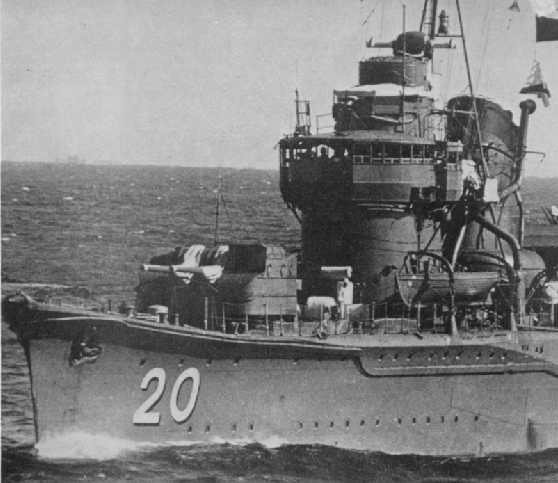
The 12.7 cm/50 Type 3 naval gun was a medium-caliber dual purpose naval gun of the Imperial Japanese Navy, standard weapon for Japanese destroyers rom 1928 and until 1944 (The Akizuki and Matsu classes were exceptions). These were taunted as true dual-purpose but this remains a nominal capability due to their bag propellant and hand ramming requiring a fixed elevation between 5–10° also translated into a rate of fire of 5–10 rounds per minute, training speed of only 6° per second. Somewhat useful in 1930 it was hoepeless against 1942 aircraft.
The Type 3 gun was of built-up construction with 3, then 2 layers, breech ring and breech bush (Welin interrupted screw breech) and still used powder bags, whereas the shell was fuzed manually on the loading tray before ramming by hand with the pusher-type shell hoist and manually insterted powder bags.
The Model A turrets of the Fubuki-class were just weather/splinter/gas proof 9–12 mm thick (0.35–0.47 in) and so fully enclosed. Later twin mounts had individual cradles to elevate separately and weighted c32 tonnes, traversing at 6° per second, elevated 6°-12° per second to +40°.
Model B mount elevated to 75° but shield reduced to 3.2 mm (0.13 in) thick and later reinforced again.
The Model C was adpted by the Shiratsuyu, Asashio, and Kagerō-class, with elevation down to 55°, depression to −7° and lighter
The Model D used by the Yūgumo-class/Shimakaze destroyers, retaining the same depression but elevation to 75°.
Mount weight: Type A/B 18.5 tonnes (18.2 long tons; 20.4 short tons)
Round: 23 kg (51 lb) HE, illumination, incendiary shrapnel (sankaidan) for AA use, flat-nosed ASW (1943). 1945: HE developed with added charge for 23,025 metres (25,180 yd).
Propellant: 7.7 kg (17 lb) 30 DC.
Muzzle velocity:
-Common Type 0 HE 23 kg (51 lb)/1.88 kg (4.1 lb): 910–915 m/s (2,986–3,002 ft/s)
-Common Type 1 HE 23 kg (51 lb)/1.88 kg (4.1 lb): 910–915 m/s (2,986–3,002 ft/s)
-Illumination 23 kg (51 lb): 750 m/s (2,500 ft/s)
-ASW 20.9 kg (46 lb)/4 kg (8.8 lb): 250 m/s (820 ft/s)
-HE 1945 LG type 27.9 kg (62 lb)/2.2 kg (4.9 lb): 910–915 m/s (2,986–3,002 ft/s)
⚙ specifications 12 cm/45 3rd Year |
|
| Weight | 4,205 kilograms (9,270 lb) |
| Barrel length | 6.483 metres (21.27 ft)/ barrel 6.265 metres (20.55 ft) |
| Elevation/Traverse | -7° +40° or more and 120°/120° |
| Loading system | Welin interrupted screw, Hydro-pneumatic recoil |
| Muzzle velocity | 910–915 m/s (2,986–3,002 ft/s) |
| Range | 18,400 metres (20,100 yd)/40° |
| Crew | 6 |
| Round | 20.3 kg (45 lb) 120 x 550 mm.R., sep. loading cased charge |
| Rate of Fire | 5–10 rpm |
The Hatsuharu-class and rebuilt heavy cruisers had these also and soon swapped the old Type 8 for the better Type 90 torpedo replacing them all. The latter was developed from 1928 and adopted in 1932, replacing the Type 8.
The Hatsuharu class had initially nine 61 cm Type 90 torpedo was mounted in three triple tube Type 90 Model 2 launchers, derived from the twin tube Type 89 launcher on the Takao-class. These were also shielded, both on the torpedo mounts and locker to keep away waterspray and stop strafing aircraft fire. These Duralumin shields to save weight (a well known aviation composite) still corroded and had to be replaced, plus these materials were badly needed by the Japanese aircraft industry later in the war.
Instead, the shields were redone in “NiCrMo” steel, using surplus air chambers material from obsolete torpedoes. It was 3 mm (0.12 in) in thickness and coorodoed far less. The Type 90 Model 2 overall weighted 14.4 tonnes (14.2 long tons; 15.9 short tons) with torpedoes. This were lightweight compared to the 14.5 tonnes (14.3 long tons; 16.0 short tons) of the Type 89. They had an electro-hydraulic system for a powered 360° traverse in 25 seconds or manual backup in two minutes. Each tube was reloaded in 23 seconds with an endless wire and winch. Of course with measures taken to regain stability the aft superfiring mount was deleted well before WW2. The ships operated thus with 6 TTs and 6 reloads.
Type 90 (1930)
This new type was adopted originally for heavy Cruisers and Fubuki destroyer classes only. Development started in 1928 and was completed in 1932, with introduction made in 1930 for tests and strict service adoption in 1933. It had a more powerful engine of the one used in the 53 cm Type 89. The starting point were the 46-knot (85 km/h) 21-inch (53 cm) Whitehead torpedoes and instead of a radial they used a new double-action two-cylinder engine. The compacity and extra power meant more speed but shorter range. Neither of the resulting 6th and 8th Year torpedoes were manufactured, but they led to the Type 90.
It’s thus not known if the Mutsuki were ever fitted with these or instead swapped directly to the Type 93.
⚙ specifications Type 90 |
|
| Weight | 2,605 kg (5,743 lbs.) |
| Dimensions | 8.485 m (27 ft 10 in) x 60.9 cm (24.0 in) |
| Propulsion | Kerosene-air wet-heater |
| Range/speed setting | 7,000 m/46 kts; 10,000 m/42 kts; 15,000 m/35 kts |
| Warhead | 827 lbs. (375 kg) Type 97 |
| Guidance | Straight course |
Type 93 (1933)
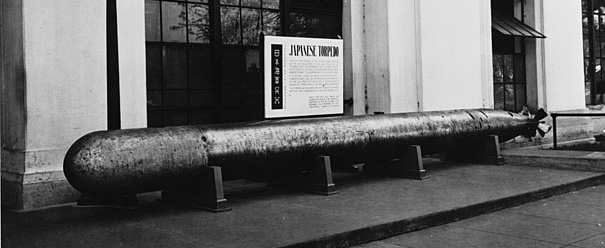
The Type 93 entered service in 1933 (model 1) and the ships were possibly rearmed in 1935-36 or never, it’s not strictly confirmed. The Type 90 could have been installed instead when available.
61 cm Type 93 torpedo found on the Mutsuki, Fubuki, Akatsuki classes, and all oxygen fuelled from the Hatsuhara and beyond. The Designer was Rear Admiral Kaneji Kishimoto, and Captain Toshihide Asakuma, and this started in 1928 (just as the last Mutsuki class ships were completed), then went on until 1932. The Type 93 became the nororious “secret weapon” unleashed by IJN destroyers and cruisers in WW2, which caused extebsive damage during the Solomons campaign expecially. The defective US Type 14 torpedo was in stark contrast with this. The Type 93 torpedo was dangerous to its user however but its effectiveness outweighed the risks anyway, claiming 23 Allied warships, 11 cruisers, 11 destroyers, and a fleet aircraft carrier and among these, 13 hits were fatal.
⚙ specifications Type 93 |
|
| Weight | 2.7 tonnes (6000 lb) |
| Dimensions | 9 metres (29 ft 6+5⁄16 in) x 610 mm (2 ft 1⁄64 in) |
| Propulsion | Oxygen-enriched air |
| Range/speed setting | 2,000 m (24,000 yd) at 48–50 kts or 40,400 m (44,200 yd) at 34–36 kts |
| Max speed | 96 km/h (52 kn) |
| Warhead | 490 kg (1080 lb) |
| Guidance | Straight course |
AA Defence
As completed they were fitted by the engineers by two water-cooled, license-built Vickers 40-millimeter guns the famous “pom pom” of WWI vintage. They brough a considerable firepower, albeit being heavy and slow-firing, short-ranged for 1930s standards. When possible, they were replaced by new license-built French Hotchkiss 25 mm (0.98 in) Type 96 anti-aircraft guns.
13.2 mm Type 93 heavy machine gun
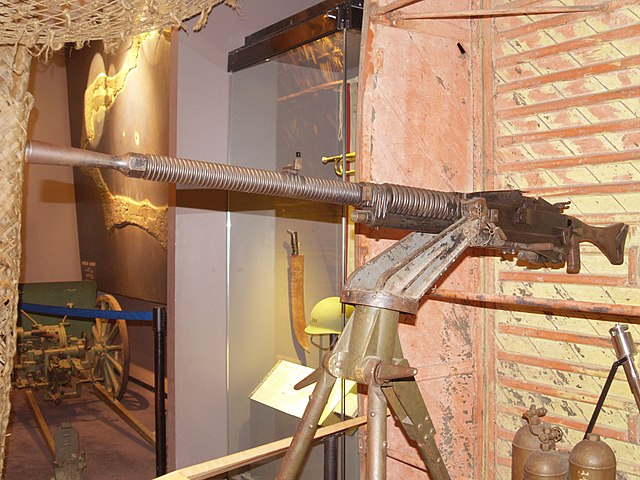
The Type 93 13 mm (0.55 inches) heavy machine gun (九三式十三粍機銃), Type Ho 13 mm AA machine cannon was a license-built version of the French Hotchkiss M1930 machine gun. It was widely used for heavy ground support and organic for AA defence, until gradually replaced when possible by the 25 mm Type 96. They were still in use, on twin mounts, on many IJN cruisers and destroyers before WW2 but gradually replaced when possible, notably by single 25 mm mounts due to unsufficient range and firepower.
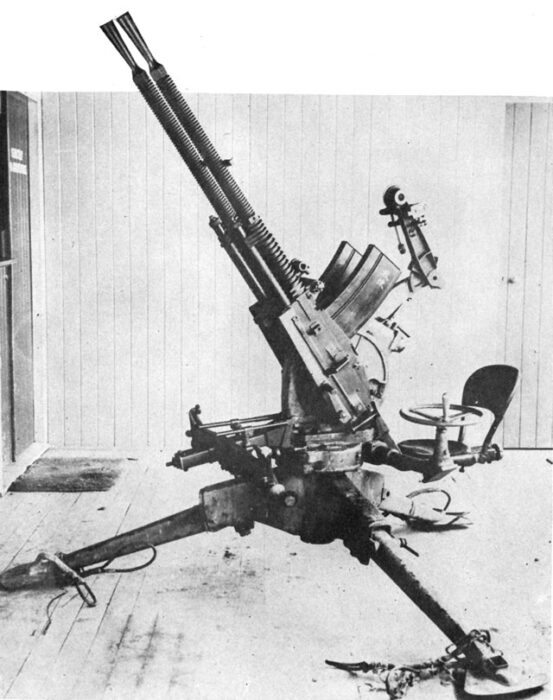
The common twin mount in 1941
Tech specifications Type 93 heavy machine gun |
|
| Barrel Lenght | 140 centimeters (55 in) total, 988 millimeters (38.9 in) barrel alone |
| Mass | 42 kilograms (93 lb) (empty) |
| Fully loaded | ? |
| Shell | 13.2×99mm Hotchkiss |
| Exact caliber | 13.2 mm |
| Barrel type | A tube with progressive RH parabolic twist, 9 grooves |
| Action | Gas-operated fully automatic |
| Elecation/Traverse | -15 / +85°, 360° traverse, manual |
| Rate of fire | 450 rounds/min Max |
| Muzzle velocity | ? |
| Effective range | 1,000 meters (3,300 ft) |
| Maximum firing range 45° | ? |
| Feed system | Classic box magazine holding 30 rounds |
| Sight | Spiderweb anti-aircraft iron sight |
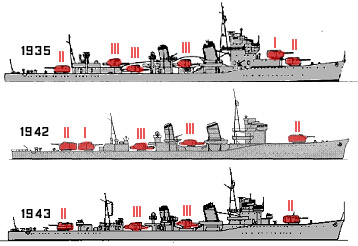
Evolution of the Hatsuharu class
In WW2 they were generously peppered in single, double and triple mounts, especially from 1943 for last afloat in class. Hatsuharu at the end of her life at three triple, power-driven mounts replacing the single 5-in turret with a superb arc of fire forward, and there was one additional twin power-driven mount, fitted on a platform, in front of the bridge creating another level, as well as two hand-worked single mounts.
The powered mounts were unsatisfactory because of their traverse and elevation speeds. Lighter single mounts, that could be manually traversed, were fitted in 1945 like on Hatsushimo (ten single 25 guns).
25 mm Type 96

The type 96 25 mm AT/AA gun became the standard of the IJA and IJN, automatic cannon developed as variant of the French Hotchkiss 25 mm, dual-purpose and developed as AA on single, twin and triple mounts. Development worked on 1935. 25 mm Hotchkiss design evaluated and order placed for several mounts types for evaluation at Yokosuka Naval Arsenal. Led to the Type 94 and Type 95 and then the main model produced at Yokosuka Arsenal, the Type 96.
Elements made with castings and not forging for larger production, Rheinmetall supressor, new mounts designed.
Air-cooled gas operated with multiple rings (Hotchkiss patent).
Twin-mount in 1939, followed by triple mount in 1941 and single mount in 1943.
Issues of the designed revealed in combat:
Slow elevation and traverse, ineffective sights, excessive vibration, limited magazine cap., blinding Flashes.
The 1944 single mount needed a single operator and a loader but had a better spiderweb sight.
Tech specifications 25 mm Type 96 |
|
| Barrel Lenght | 1.5 m (4 ft 11 in) L/60 |
| Barrel weights: Single | 785 kg (1,731 lb) |
| Barrel weights: Twin | 1,100 kg (2,400 lb) |
| Barrel weights: Triple | 1,800 kg (4,000 lb) |
| Crew: | 3, 7 and 9 respectively |
| Shell | 25×163mm |
| Exact caliber | 25 mm (0.98 in) |
| Action | Gas operated |
| Elevation/Traverse | -10°/+85° – 360°, manual |
| Rate of fire | 200–260 rpm (cyclic) |
| Muzzle velocity | 820 m/s (2,700 ft/s) |
| Effective range | 6.8 km (4.2 mi) at 45° with HE shell |
| Maximum firing range 85° | 3 km (9,800 ft) effective, 5.5 km (18,000 ft) max. |
| Feed system | 15-round box magazine |
| Production | 33,000 all variants 1935-45 |
Depth Charges
The Hatsuharu class carried “only” eighteen depth charges initially in a single rack at the stern. This increased to thirty-six after late 1942. No sonar or hydrophones were fitted also at first, but in early 1942 a Type 93 sonar and Type 93 hydrophones were integrated. They were inferior however to allied designs.
The single Type 81 depth charge launcher at the stern (18 depth charges) could allow dropping the standard Type 95, 30.5″ by 17.7″ (77.5cm by 45cm). 220 lb (100 kg) charge, Type 88 explosive (ammonium perchlorate and ferrosilicate). Fuse using a water inlet. 100 feet (30m) and 200 feet (60m) settings (after the revelations of a US Congressman).
Later increased to 324 lb (147kg), Type 97 explosive (70% TNA/30% HNDA), 300 foot (90m) setting.
-1944 Type 2: 230 lbs (105kg) Type 97 explosive settings 98, 197, 292, 390, 480 feet (30m, 60m, 89m, 120m, and 145m).
-1945 Type 2: 357 lbs (162kg) explosives.
Mines
20 mines on rails, no precision given. Can be any of the models here.
The ships were also given an optional mechanical minesweeping gear.
Sensors (WW2)
They received a Type 22 radar in November 1943, the remaining seven as well from 1944. Survivors received the Type 13 radar.
Type 22 radar
The early Type 22 General Purpose Radar looks like characteristically like a 2910 lb (1320 kg) drum topped with a twin cornet amplificators, mounted mid-way top the mast.
Specs:
Wavelength 10 cm, pwd 10 microsecond, PRF 2500 Hz, scan rate 5 rpm, PP 2 kW
Range: 20 nautical miles (35 km) aircraft group, 10 nm (17 km) single, 13 nm(24 km) battleship.
Subject to land clutter. Horn and A scope display, accuracy 220 yards (200m)/3 degrees res. 1600 yards (1500 m)/40 degrees
300 sets produced installed on destroyers from the summer 1942. Generalized in 1944.
Type 13 radar
Vertical 240 lb(110 kg) bedframe antenna, developed 1941, introduced mi-1943, with vertical dipole transmitter and Yagi mattress receiver. 1000 sets produced. Air defense, range 100 km (group), and single aicraft 50km.
Specs:
Wavelength 200 cm, pw 10 ms, PRF 500 Hz PP 10 kW
Range: 30-60 nautical miles (50-100 km)
⚙ Hatsuharu class specifications |
|
| Displacement | 1,530 long tons (1,510 t) standard ? long tons FL |
| Dimensions | 109.5 x 10 x 3.38 m (359 ft 3 in x 32 ft 10 in x 11 ft 1 in) |
| Propulsion | 2 shaft Kampon GST, 3 boilers 42,000 hp (31,000 kW) |
| Speed | 36 knots (41 mph; 67 km/h) |
| Range | ,000 nmi (7,400 km) at 14 knots (26 km/h) |
| Armament | 2×2 127 mm/50, 2× Type xx 40 mm AA, 2×3 TTs 610 mm (18), 18 DCs |
| Sensors | Type 93 sonar, Type 2/3 radars (1944) |
| Crew | 212 |
Career of the Hatsuharu class
 IJN Hatsuharu
IJN Hatsuharu

IJN Hatsuharu (初春, “Early Spring”) was laid down at Sasebo Naval Arsenal on 14 May 1931, launched on 27 February 1933 and completed on 30 September 1933. She was rebuilt twice after the Tomozuru and 4th fleet incidents. At Pearl Harbor she joined Destroyer Division 21, Destroyer Squadron, 1st Fleet with her sisters Nenohi, Wakaba, and Hatsushimo. She remained in home waters on ASW patrol. By late January 1942 she joined the invasion force in the Netherlands East Indies, covered on 24 January 1942 the landings at Kendari (Sulawesi) in “Operation H”.A day later she was damaged in a collision with IJN Nagara and had emergency repairs at Davao. On 11 February, she escorted tankers to Balikpapan, Tarakan and Makassar and was back to her unit on 26 February then proceeded to to Sasebo by late March forrefit and repairs.
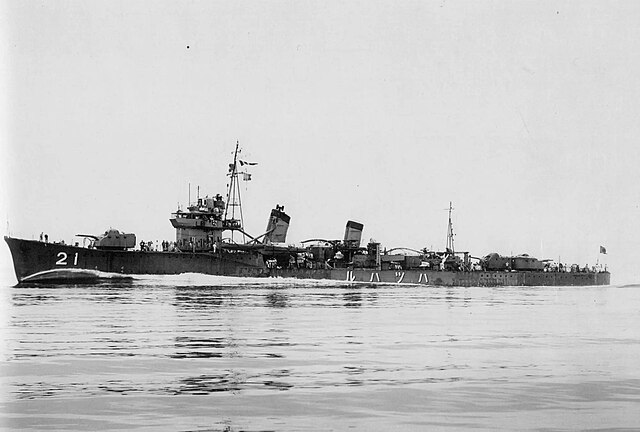
From May 1942, she was sent to the north at Ōminato Guard District, escorting IJN Abukuma in “Operation AL”, supporting Admiral Boshiro and his Northern Force in the Aleutians. She was present at Attu, Kiska and Amchitka and stayed until mid-July, had a short refit at Yokosuka and returned to the Chishima Islands, Paramushiro, Shumshu and arrived to Kiska in transport runs of reinforcements. On 17 October, while with Oboro she wa stargeted by USAAF B-26 Marauder off Kiska and received a direct bomb hit on her stern. She lost her rudder (4 killed, 14 injured) while Oboro was mortally wounded and sank. She rescued 17 survivors and limped back to Paramushiro on 25 October for provisional repairs, completed at Maizuru Naval Arsenal on… 30 September 1943, amost a year. She was modernized, receiving many 25 mm (0.98 in) Type 96 AA guns and Type 22 radar.
She then had trials, fixes, re-training, and was only operational from 11 October 1943, being underway with Hatsushimo to escort CVs IJN Ryūhō and Chitose to Singapore. On 24 November she escorted Hiyō with Hatsushimo and Wakaba from Kure to Truk via Manila and Singapore as well as Tarakan and Palau. She was back home escorting Unyō and Zuihō to Yokosuka in December 1943.
In January 1944, Hatsuharu was assigned directly to the Combined Fleet headquarters for more escorts between Yokosuka and Truk and was back to the northern district from February to late June, modernized at Ōminato and Yokosuka. In July she made two troop transport runs to Iwo Jima and obtained a Type 13 radar later that month. From August to October she escorted troop convoys to Taiwan and Luzon. On 24 October she was present at the Battle of Leyte Gulf rescuing 78 survivors from Wakaba (sunk by aircraft from USS Franklin off Panay).
In November she was sent to Manila, escorting troop convoys to Ormoc but on 12-13 November there was a night air raid in Manila Bay and she was soon framed by many near misses buckling plates, starting fires. She sank in shallow water, loosing 12 crewmen trapped inside or killed by explosions, with 60 injured, 218 survivors. She was stricken on 10 January 1945.
 IJN Nenohi
IJN Nenohi
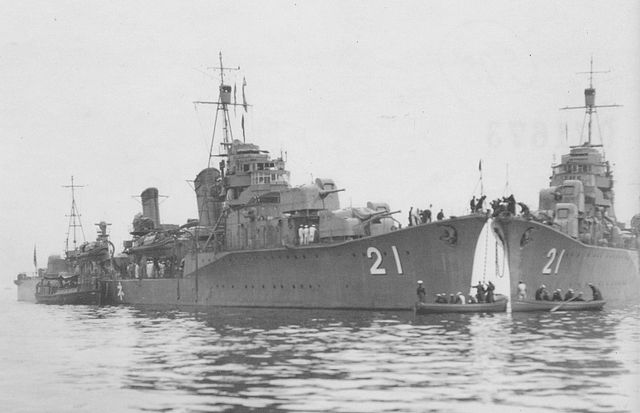
IJN Nenohi (子日 “New Years Day”) was laid down at Uraga Dock Company on 15 December 1931, launched on 22 December 1932 and completed 30 September 1933. She was assigned to the IJN 2nd Expeditionary Fleet and covered the landings in the Invasion of French Indochina. She was sent in Hanoi to coordinated efforts as as a radio station and later based at Haiphong, as a guard ship.
In December 1941 she became flagship of Destroyer Division 21, Destroyer Squadron 1, 1st Fleet, keading her sisters Hatsuharu, Wakaba, and Hatsushimo but remained at home for ASW patrol. By late January 1942 she was sent to assist the invasion of the Netherlands East Indies, covering landings at Kendari on 24 January and on Makassar on 8 February, Bali, Lombok on 18 February and back to Sasebo in late March for refit.
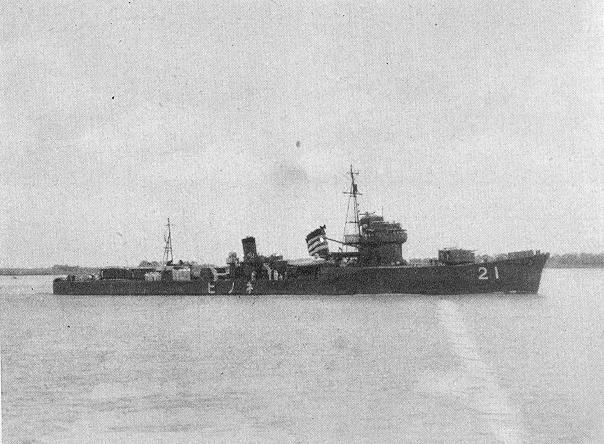
From May 1942 she was reassigned to northern operations, deployed from Ōminato Guard District in “Operation AL”, Aleutians campaign. On 4 July 1942, IJN Nenohi was torpedoed and sunk by the the Gato-class USS Triton, while escorting the seaplane tender Kamikawa Maru, southeast of Attu, off Agattu Island. Her belly rippsed ope, she capsized in 2 minutes, and sank in 5 minutes with 188 trapped inside, including Lt. Cdr. Terauchi, and 38 survivors rescued by IJN Inazuma.
On 31 July 1942 she was removed from the navy list.
 IJN Wakaba
IJN Wakaba
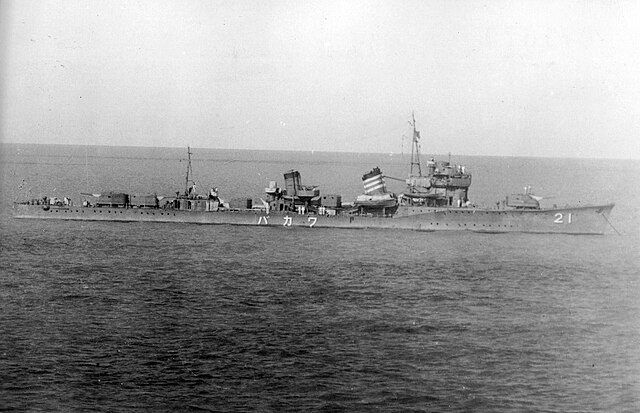
Wakaba (若葉 “young leaves”) was laid down at Sasebo Naval Arsenal on 12 December 1931, launched on 18 March 1934 and completed on 31 October 1934. Wakaba joined the 2nd Fleet and took part from 1937 to the Second Sino-Japanese War and supported landings in Shanghai and Hangzhou. From 1940 she covered landings in south China and French Indochina.
In December 1941 she was flagship of DesDiv 21, DesRon 1, 1st Air Fleet with Hatsuharu, Nenohi, and Hatsushimo and kept for ASW patrols in home waters. By late January 1942 she took part in the invasion force over the Netherlands East Indies (Operation H) and was present for the landings at Kendari (Sulawesi, 24 January) and Makassar on 8 February as well as Bali and Lombok (18 February). She was sent back for a refit to Sasebo at the end of March.
From May 1942, Wakaba was sent for the northern sector at the Ōminato Guard District and soon was impressed in Operation AL, the Aleutian invasion under orders of Admiral Boshiro Hosogaya in the “Northern Force”; She escorted ships, supported landings and patrolld around Attu, Kiska and Amchitka until mid-July. She was soon back at Yokosuka for a refit and went on patroling in the Chishima Islands as well as patrolling at Paramushiro and Shumushu and up to to Attu and Kiska, through a serie of relativey uneventful transport runs, bringing in supplies and reinforcements. This went upuntil December.
She was back to Sasebo by the fall of 1942, and had immediately a refit and modrnization with new Type 96 25 mm AA replacing her antiquated aft 40 mm (1.6 in) pom pom.
She was back in the Aleutians from January 1943 and multiplied patrols and resupply runs. On 26 March 1943 she took an active part in the Battle of the Komandorski Islands with the 5th Fleet. She attacked at long range with torpedoes but missed, whereas she collided with Ikazuchi on 30 March, and was forced to returned home with the heavy cruisers Nachi and Maya to Yokosuka.
Staying in the 5th Fleet she returned again in the Aleutians by late April and covered convoys between Paramushiro and Ōminato, until early July. Then she started to take part in the evacuation of the Aleutians, as part of the screening force (Hatsushimo, Naganami, Shimakaze and Samidare). On 26 July she was rammed by Hatsushimo, right on her stern. She had her rudder torned off and one propeller shaft out-of-line. She was forced back to Sasebo and stayed there for two months but was modernized as well with a Type 22 radar, and her “X” turret replaced by additional 25 mm anti-aircraft guns. She was back in operations by mid-October.
From 24 November she escorted IJN Hiyō from Kure to Truk (via Manila, Singapore, Tarakan and Palau) and back always in escort this tome of IJN Unyō and Zuihō to Yokosuka for their own refits in December.
In January 1944 she joined the Combined Fleet headquarters for more high profile escort missions, always from Yokosuka to Truk and back. By late February and until late June and rearmed with more AA after a refit at Ōminato (late May) and at Yokosuka (late June). From July, she carried out two dangerous troop transport runs to Iwo Jima, which was known to be soon targeted by a US landing. At her return she was installed a Type 13 Radar and from August to October, she escorted troop convoys from Kure to Taiwan and Luzon.
On 24 October 1944 she took part in the Battle of Leyte Gulf. IJN Wakaba was sunk by USS Franklin’s air group: An avenger made its mark with a torpedo and she probably took one or two bombs as reported. This happened while she was on the west coast of Panay, rescuing 78 survivors, Hatsushimo rescued 74 survivors. She was officially stroken on 10 December 1944.
 IJN Hatsushimo
IJN Hatsushimo
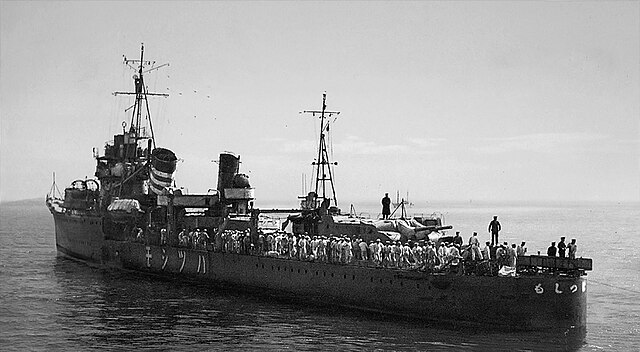
Hatsushimo (初霜 “first frost”) was laid down at Uraga Dock Company on 31 January 1933, launched on 4 November 1933, and completed on 27 September 1934. On completion, she was assigned to the IJN 2nd Fleet and took part in the Second Sino-Japanese Wa, from 1937, Hatsushimo, covering landing of Japanese forces in Shanghai and Hangzhou. From 1940 she covered landings in south China and in the Invasion of French Indochina.
By December 1941 she was in DesDiv 21, DesRon 1, 1st Fleet with Hatsuharu, Nenohi, and Wakaba. She took part in the invasion of the Netherlands East Indies (“Operation H”) and covered the Kendari-Sulawesi landings on 24 January as well as Makassar on 8 February, Bali and Lombok on 18 February. She was back at Sasebo Naval Arsenal in March for a refit.
From May 1942, she joined northern operations from Ōminato Guard District and accompanied Abukuma in “Operation AL” with Admiral Boshiro Hosogaya in the Aleutians, soldiering in Attu, Kiska and Amchitka before a refit at Yokosuka and going on patrol at Chishima, then deployed at Paramushiro or Shumushu and Attu-Kiska in transport runs until December. She had a new refit at Sasebo by the fall and alterations.
From January 1943, she was back for several missions in the Aleutians and on 26 March, took part in the Battle of the Komandorski Islands with the 5th Fleet, launching torpedoes bu without direct claim and withdrew with Nachi and Maya to Yokosuka in late March.
Se joined the 5th Fleet in mid-May and patrolled Paramushiro-Ōminato until late June. In July then taking part in the evacuation of the Aleutians with a screening force comprising Wakaba, Naganami, Shimakaze and Samidare. On 26 July, she however rammed Wakaba at the stern, rammed in turn by Naganami dring manoeuvers in heavy fog. She had a months of repairs in Yokosuka by September and received a Type 22 radae whereas her remaining ‘X’ turret was removed, AA added. Back in mid-October she escorted Ryūhō and Chitose to Singapore and back.
From 24 November she escorted Hiyō from Kure to Truk via Manila, Singapore, Tarakan and Palau and back home with Unyō and Zuihō. In early 1944, she joined the Combined Fleet headquarters, and went on escorting ships between Yokosuka and Truk. Back in Sasebo on 14 April, for additional AA and a new Type 22 radar she was present later in June in the Battle of the Philippine Sea (First Supply Force) and went on in these missions until September 1944. After a refit at Kure (more 25-mm AAs and a Type 13 radar added) and she continued in escort missions to the Philippines until November.
On 24 October 1944 (Leyte Gulf) she rescued 74 survivors from Wakaba, and was reassigned to the 2nd Fleet for more escort missions between Singapore and Cam Ranh Bay (French Indochina) until the fall. In February 1945 she escorted Ise and Hyūga from Singapore back to Kure (Operation Kita). In Kure she received more AA and by April 1945, she escorted Yamato for Operation Ten-Go. She rescued survivors from Yamato, Yahagi and Hamakaze.
Next she was sent to Maizuru as a training and guard vessel. On 30 July 1945 she was attacked by TF38 aircraft at Miyazu Bay, and her captain had to beach her. She had 17 crewmen killed. In fact, IJN Hatsushimo became the 129th and last destroyer of the Imperial Japanese Nav lost in WW2.
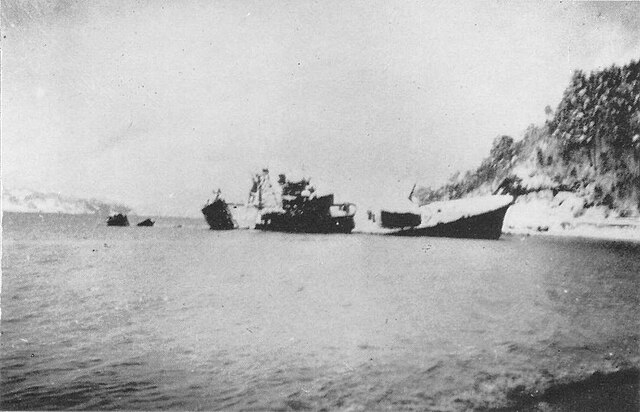
Japanese destroyer Hatsushimo in 1947
She was stricken on 30 September 1945, but her wreck (above) was salvaged and broken up in 1948-1949 with her anchor collected and saved, now exhibited in a hospital in Tokyo.
 IJN Ariake
IJN Ariake
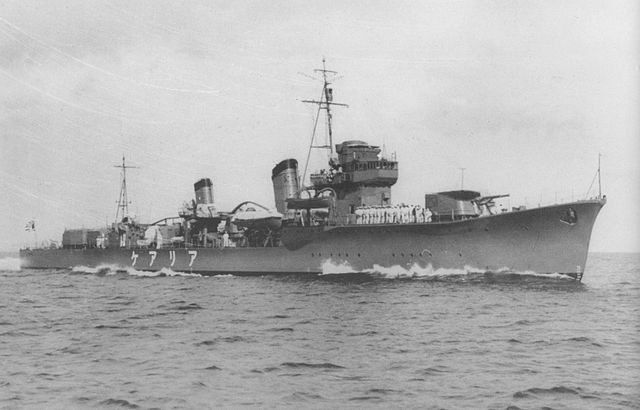
Ariake (有明 “daybreak”) was laid down at Kobe Shipyard, 14 January 1933, she was launched on 23 September 1934 and completed on 25 March 1935. She joined DesDiv 27, DesRon 1, 1st Fleet with Shiratsuyu, Shigure, and Yūgure, Hashirajima.
In January 1942 she escorted Hiryū and Sōryū to Palau-Ambon (invasion of the Netherlands East Indies) and Darwin air raid (19 February 1942). Next in Staring Bay, Sulawesi, she conducted patrols and back to Sasebo for a refit from 22 March to 15 April 1942. She was sent to Truk escorting Shōkaku and Zuikaku for the Battle of the Coral Sea. In May 1944 she escorted Myōkō and Haguro to Kure.
During the Battle of Midway like her sisters she was part of the Aleutian diversionary force and joined the 2nd Fleet on 14 July, then 4th Fleet to Truk and Jaluit on 20 August. She shelled Nauru on 23 August, and sent a landing party in “Operation RY”, waiting for a garrison force on 30 August. She took part in the Solomon Islands, she took part in in a troop transport run with the Ichiki and Aoba Detachments on Guadalcanal, shelling Henderson Field also.
From September through December 1942 he partaked in some Tokyo Express runs and on 17 December, attacked and claimed sinking an unidentified submarine, remaining unconfirmed. By late December she was caught by an air raid by USAAF B-24s and badl damaged, while towing the already damaged Uzuki. Six near misses claimed 28 crewmen, injured 40 and disabling her No.2 and No.3 gun turrets. This forced her back to Sasebo for repairs until February 1943.
Next she returned to Truk escorting a convoy by late February and another from Truk to Rabaul and back to Yokosuka. She returned to Truk with Unyō, and returned with Musashi late May. She was drydocked overhauled, and sortied with Hiyō to Truk, and back with the latter damaged. In late June, this was with Ryūhō from Yokosuka to Truk, then Kumano and Suzuya from Truk to Rabaul and again in July.
On 27–28 July 1943 while escorting a troop transport to Tuluvu in New Britain, she grounded on a reef near Cape Gloucester with Mikazuki but was able to work free, landed troops and ComDesDiv 30 from Mikazuki and tried to assist her, but was caught by USAAF B-25 Mitchells which framed her with bombs and gunfire. 7 were killed inc. her captain Lt.Cdr Akifumi Kawahashi.
 IJN Yūgure
IJN Yūgure
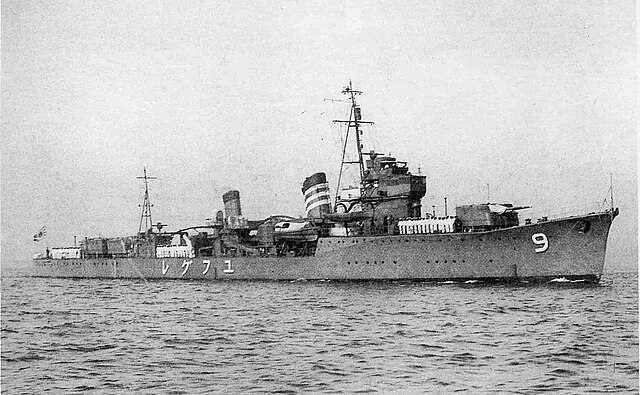
Yūgure (夕暮 “twilight”) was laid down at Maizuru Naval Arsenal on 9 April 1933, launched on 6 May 1934 and completed on 30 March 1935. In Dec. 1941, Yūgure joined DesDiv 27 of, DesRon 1, 1st Fleet with sisters Shiratsuyu, Shigure, and Ariake at Hashirajima.
In January 1942, she escorted Hiryū and Sōryū to Palau-Ambon and covered the Darwin air raid of 19 February 1942. Later she was based at Staring Bay in Sulawesi, conducting escort patrols until late March. Back to Sasebo for a refit on 22 March to 15 April she was ordered to Truk, escorting IJN Shōkaku and Zuikaku as well as taking part in Takagi’s force at the Battle of the Coral Sea.
In May, she escorted Myōkō and Haguro to Kure and was distant in the Battle of Midway, escorting the Aleutian diversionary force of Admiral Shirō Takasu. Next she was sent to the 2nd Fleet on 14 July, then detached to the 4th Fleet for a Truk-Jaluit sortie on 20 August. She shelled Ocean Island on 23 August and sent a landing party to occupy it 26 August (“Operation RY”) and waited for a garrison to arrive on 30 August. Next she sailed for the Solomon Islands, taking part in severeal Tokyo Express runs throughout until January 1943. She took part in recue operations after the first Naval Battle of Guadalcanal, notably IJN Hiei.
She returned to Sasebo for repairs until mid-January 1943, then ecorted a convoy to Qingdao, then to Palau and Wewak by late February. She escorted a convoy from Truk to Wewak, back to Yokosuka in March and back in May. Next she escorted IJN Unyō, and then the battleship Musashi by late May. By early June, she escorted Hiyō to Truk and back, damaged. By late June, she escorted Ryūhō from Yokosuka to Truk and in early June was assigned to transport runs to Kolombangara.
On 12 July 1943 she thus took part in the Battle of Kolombangara, co-claiming USS Gwin, damaging USS Honolulu, USS St. Louis and HMNZS Leander.
In the night of 19 July 1943, she was caught in a run to Kolombangara by U.S. Marine Grumman TBF Avengers from Guadalcanal, and sunk. Later the rescue destroyer Kiyonami rescued 20 but was sunk herself soon thereafter. Her crew of 228 men was lost for good.
Read More/Src
Books
Evans, David (1979). Kaigun: Strategy, Tactics, and Technology in the Imperial Japanese Navy, 1887-1941.
Brown, David (1990). Warship Losses of World War Two. Naval Institute Press.
Howarth, Stephen (1983). The Fighting Ships of the Rising Sun: The Drama of the Imperial Japanese Navy, 1895–1945. Atheneum.
Jentsura, Hansgeorg (1976). Warships of the Imperial Japanese Navy, 1869–1945. US Naval Institute Press.
Morison, Samuel Eliot (1958). The Struggle for Guadalcanal, August 1942 – February 1943, vol. 5 of History of United States Naval Operations in World War II. Boston: Little, Brown and Company.
Nelson, Andrew N. (1967). Japanese–English Character Dictionary. Tuttle.
Watts, Anthony J (1967). Japanese Warships of World War II. Doubleday.
Whitley, M J (2000). Destroyers of World War Two: An International Encyclopedia. London: Arms and Armour Press.
Evans, David (1979). Kaigun: Strategy, Tactics, and Technology in the Imperial Japanese Navy, 1887–1941.
Brown, David (1990). Warship Losses of World War Two. Naval Institute Press.
Howarth, Stephen (1983). The Fighting Ships of the Rising Sun: The Drama of the Imperial Japanese Navy, 1895–1945.
Jentsura, Hansgeorg (1976). Warships of the Imperial Japanese Navy, 1869–1945. US Naval Institute Press.
Morison, Samuel Eliot (1958). The Struggle for Guadalcanal, August 1942 – February 1943, vol. 5 of History of United States Naval Operations in World War II. Boston: Little, Brown and Company.
Nelson, Andrew N. (1967). Japanese–English Character Dictionary. Tuttle.
Watts, Anthony J (1967). Japanese Warships of World War II. Doubleday.
Whitley, M J (2000). Destroyers of World War Two: An International Encyclopedia. London: Arms and Armour Press.
Links
on blog.livedoor.jp irootoko_jr
archive.ph nishidah/
en.wikipedia.org/ Hatsuharu-class_destroyer
on combinedfleet.com hatsuharu class
on combinedfleet.com IJN hatsuhrau
on combinedfleet.com ariak
combinedfleet.com nenohi
combinedfleet.com yugure
on globalsecurity.org hatsuharu-dd.htm
web.archive.org navypedia.org/ hatsuharu
Model Kits
All kits on scalemates.com



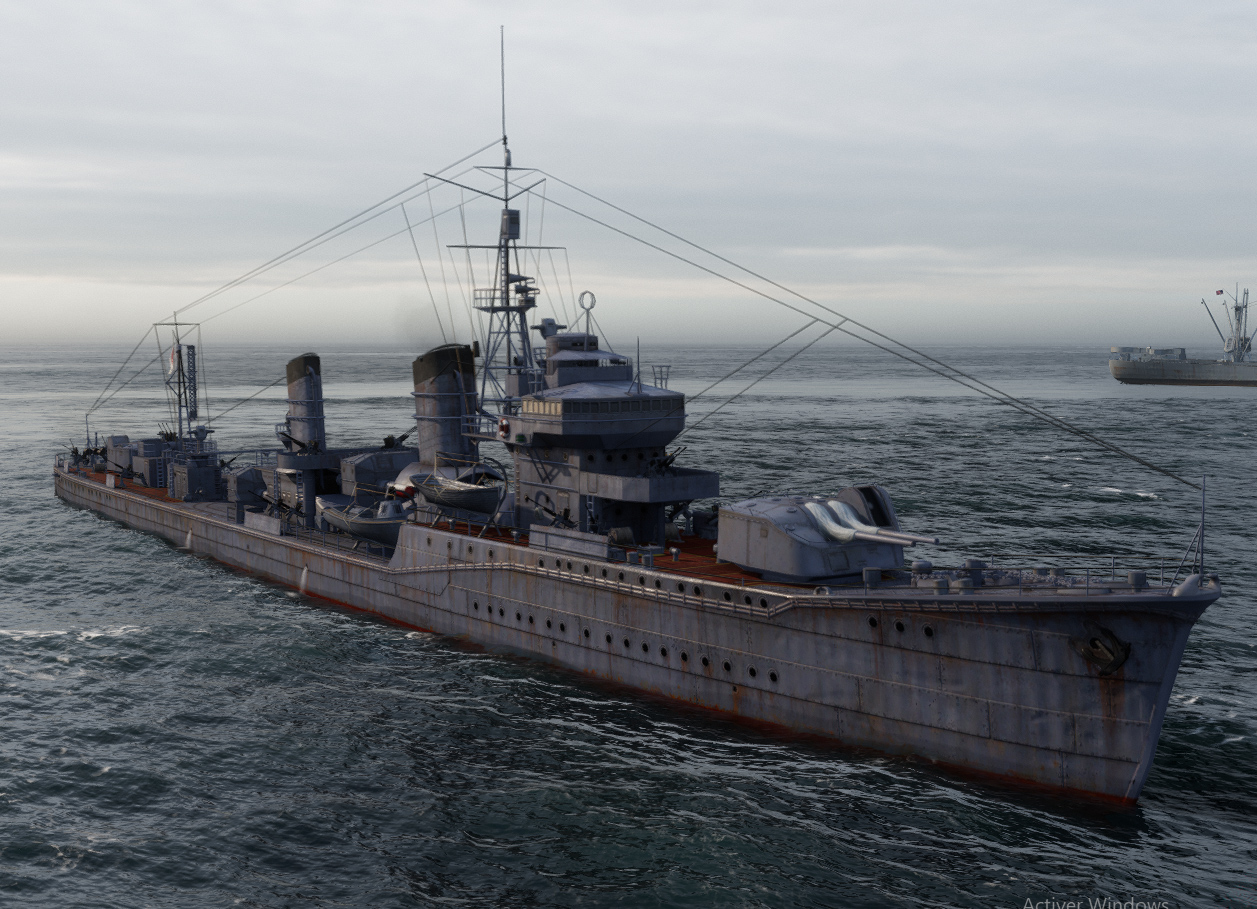
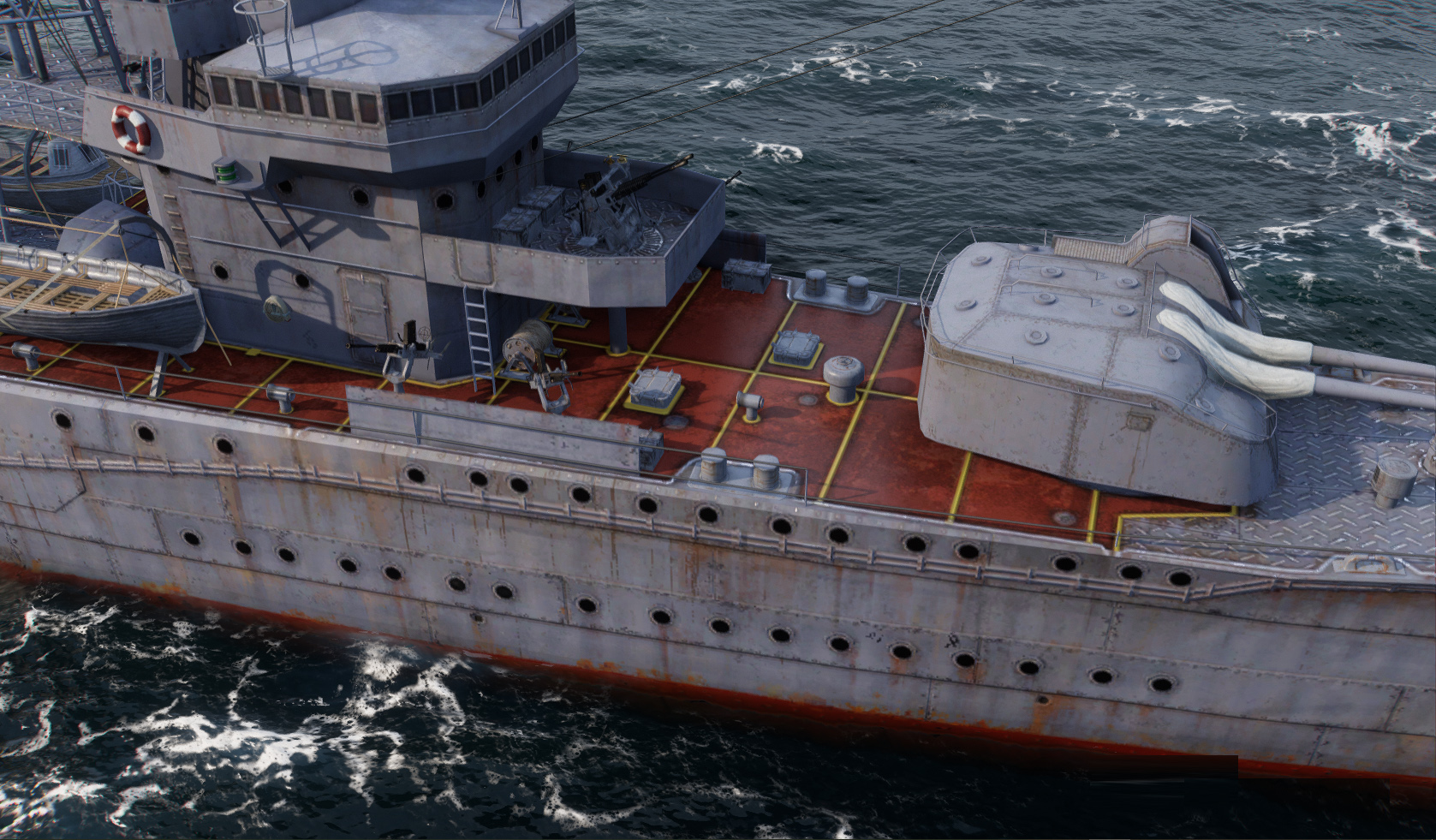
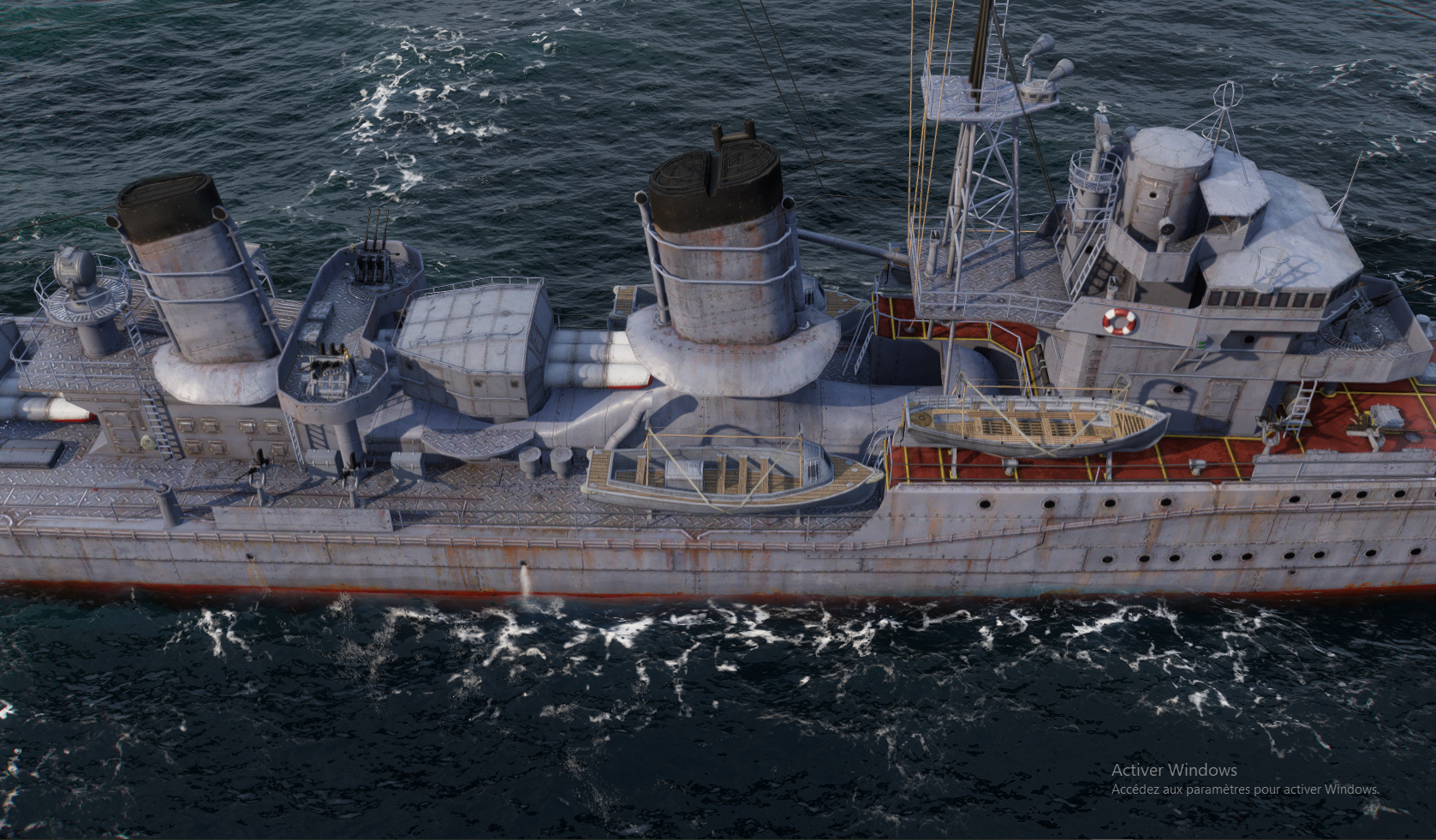
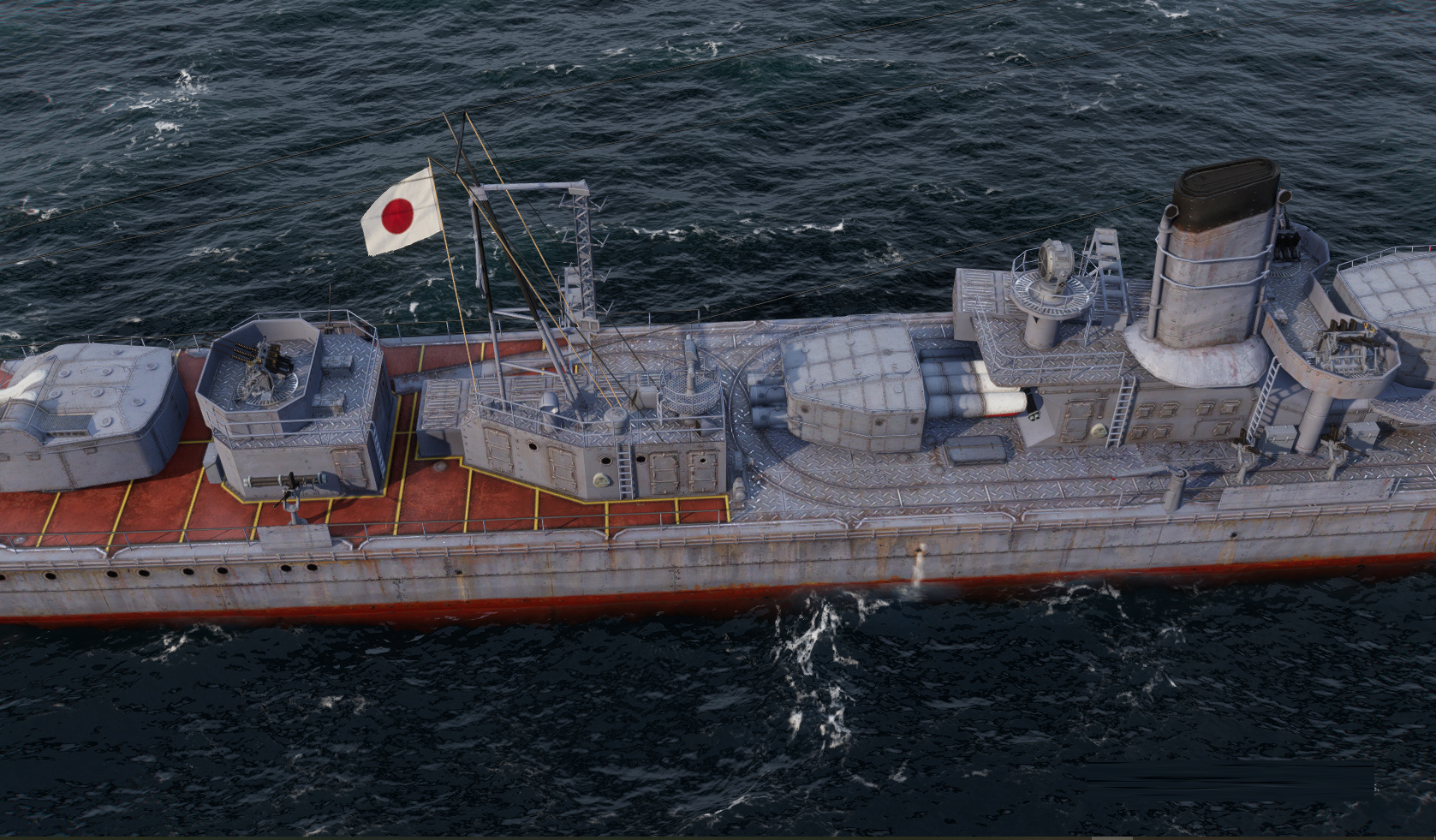
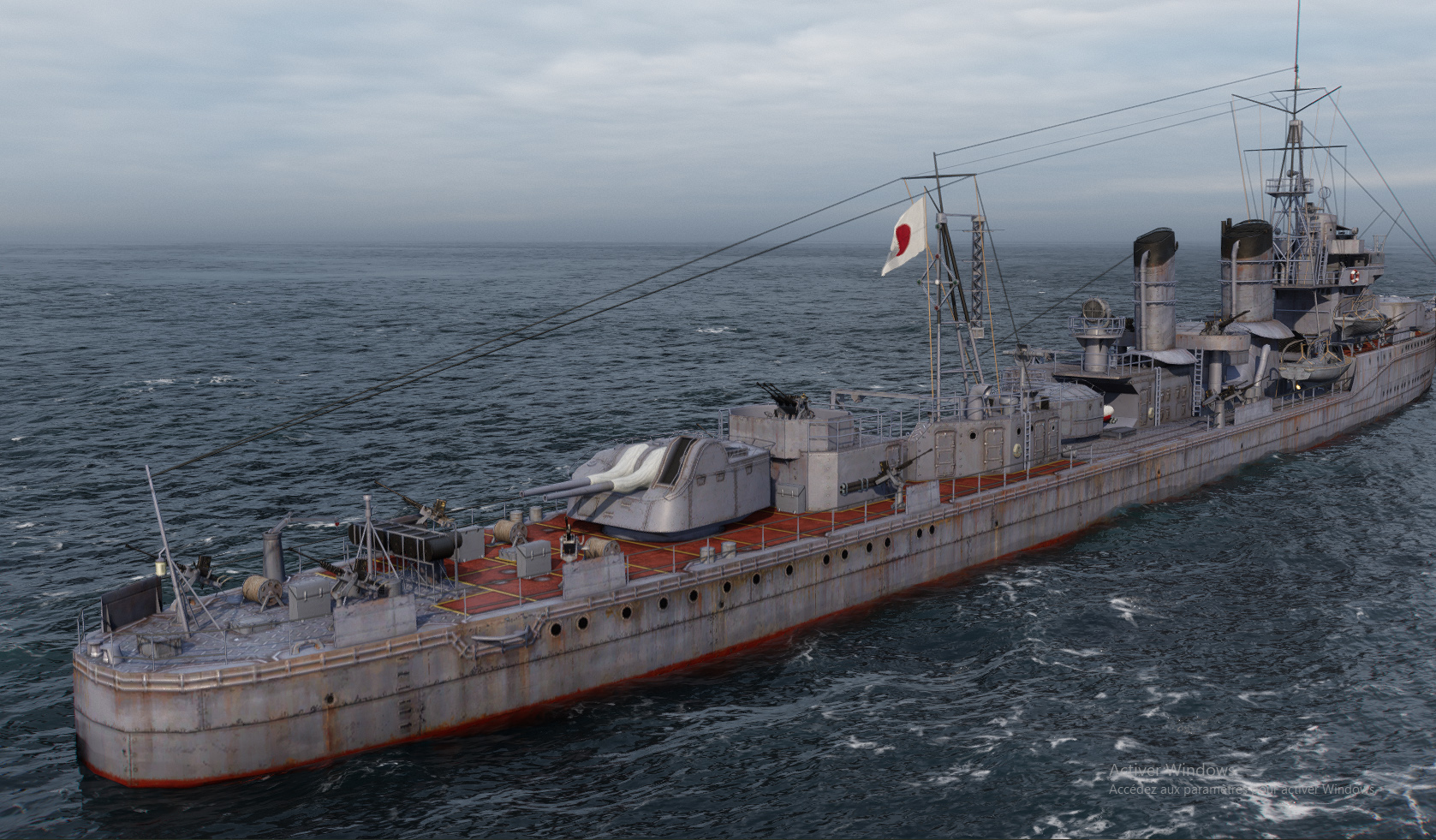

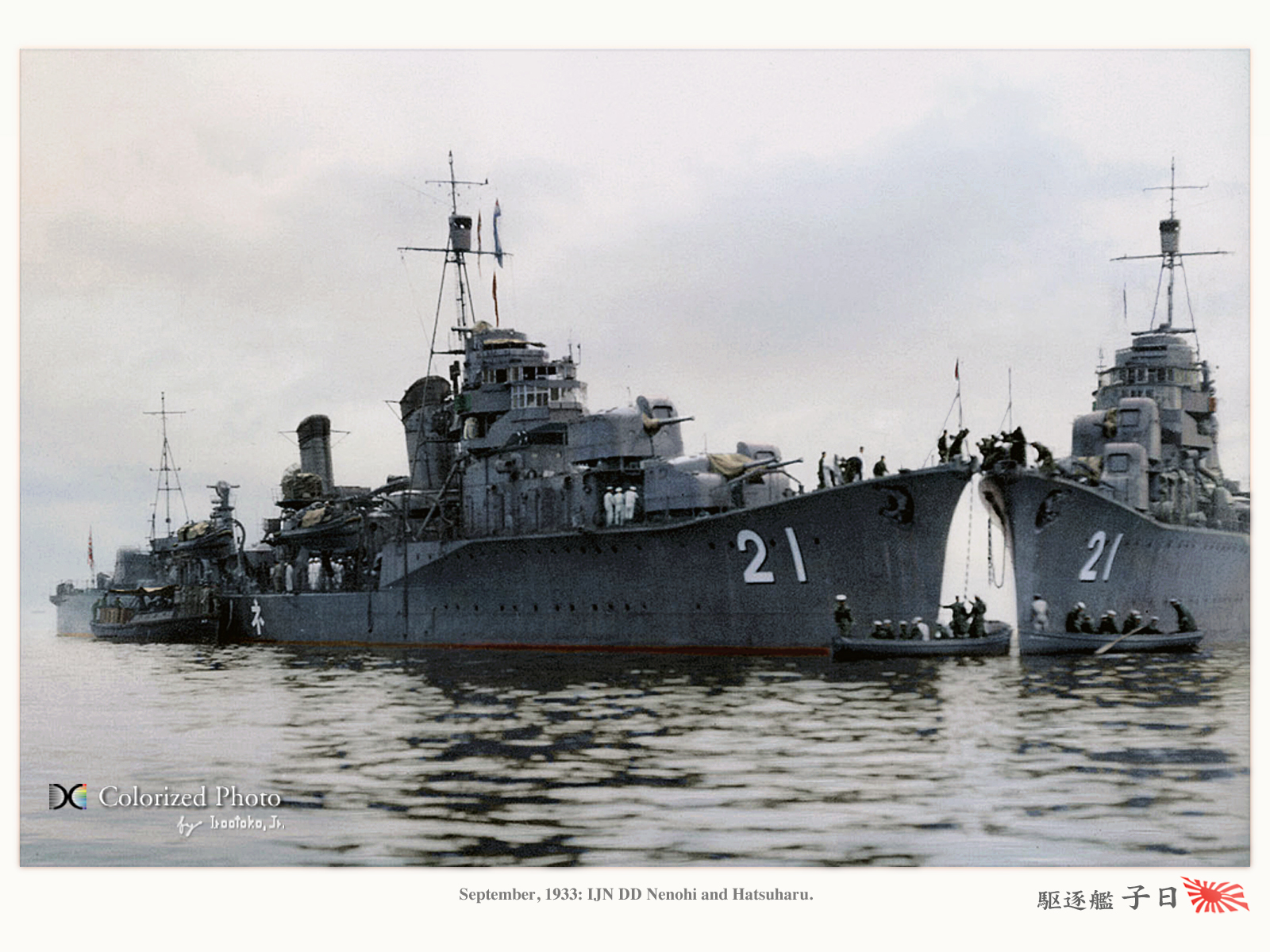
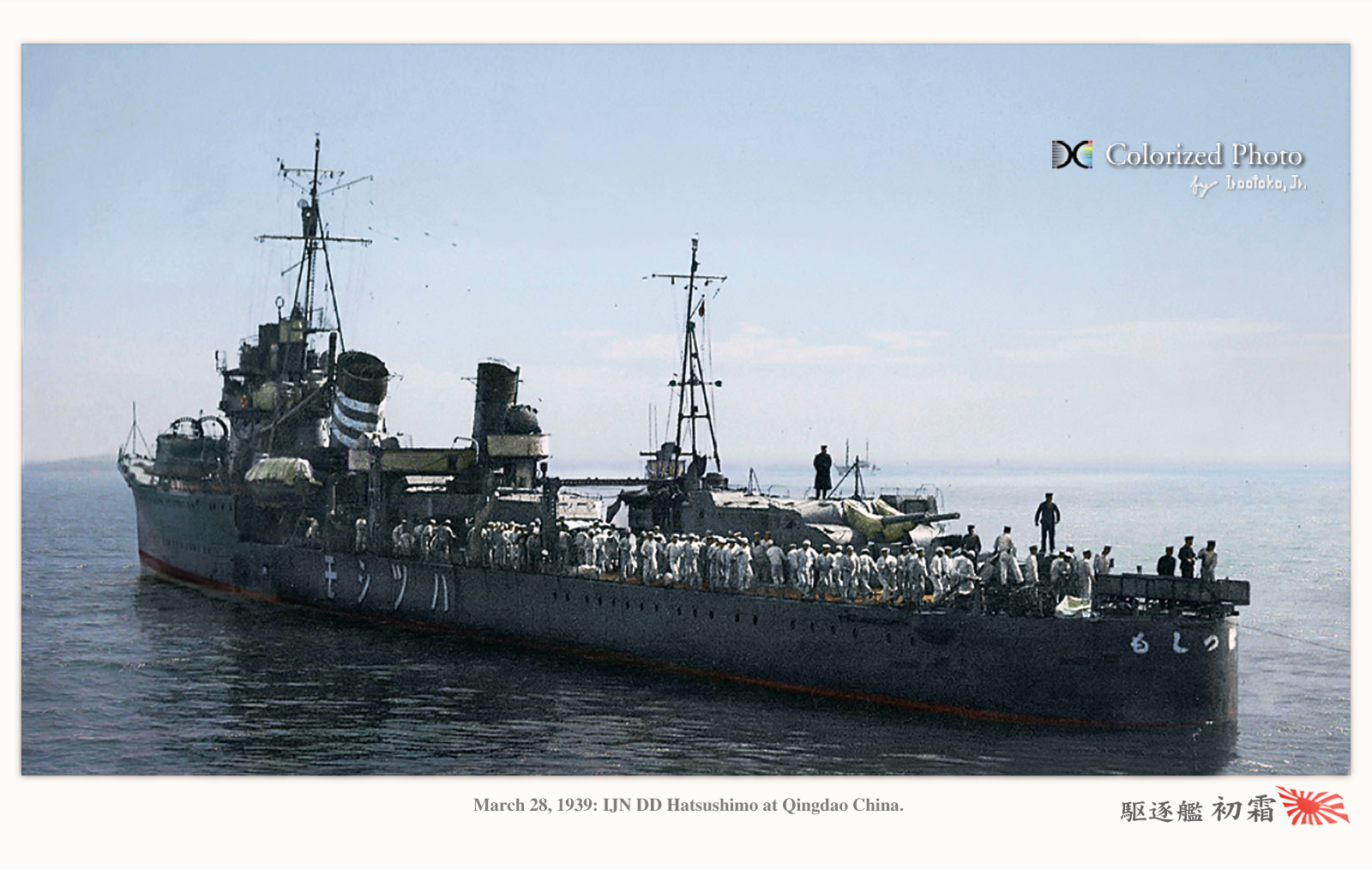
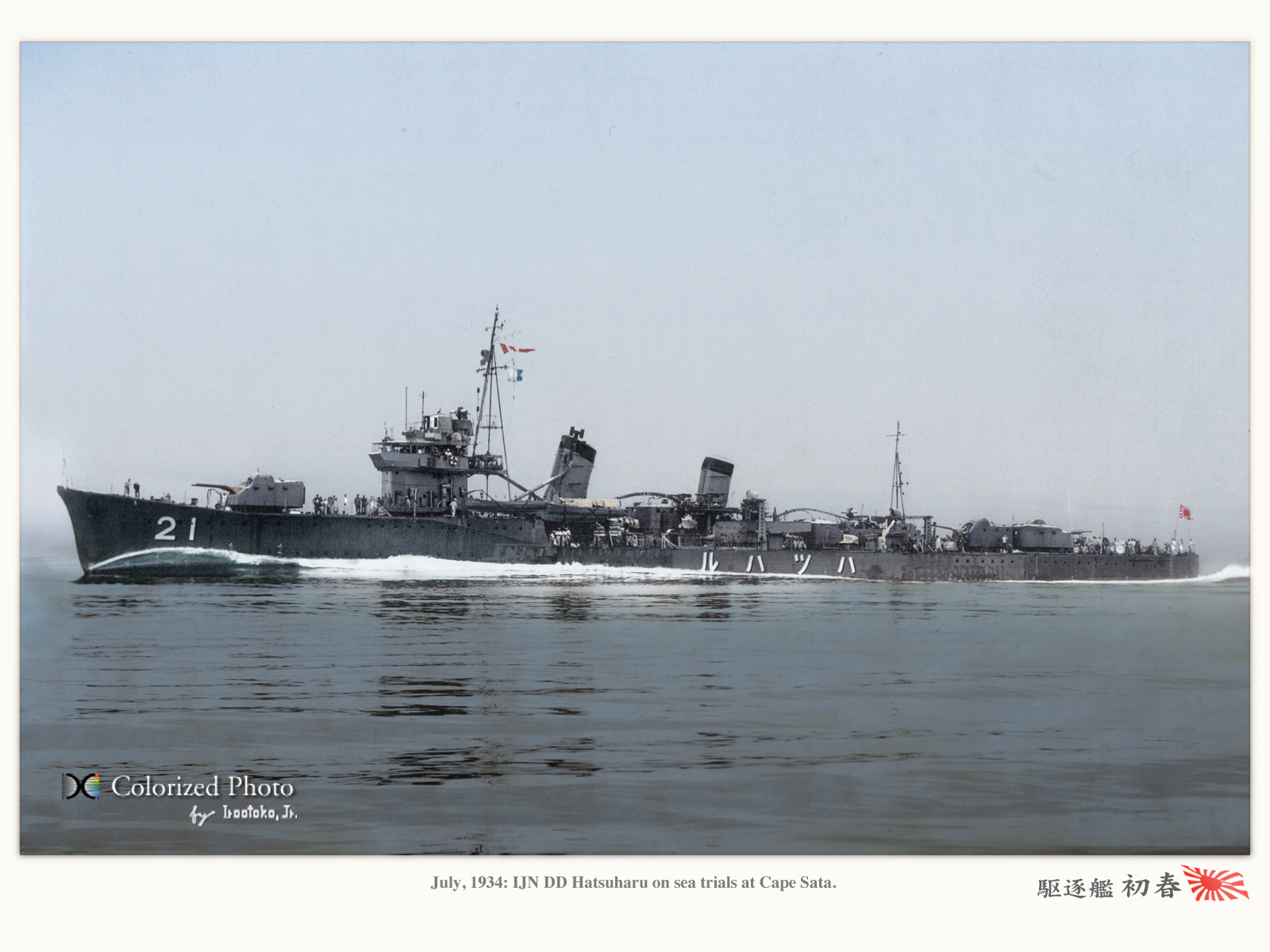
 Latest Facebook Entry -
Latest Facebook Entry -  X(Tweeter) Naval Encyclopedia's deck archive
X(Tweeter) Naval Encyclopedia's deck archive Instagram (@navalencyc)
Instagram (@navalencyc)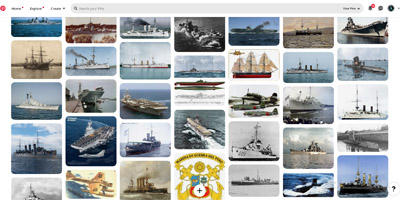

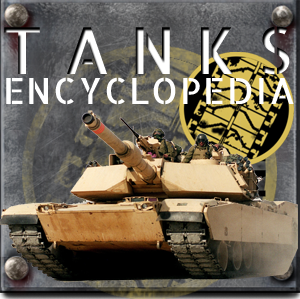
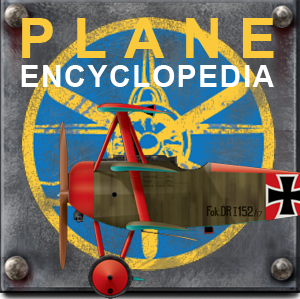
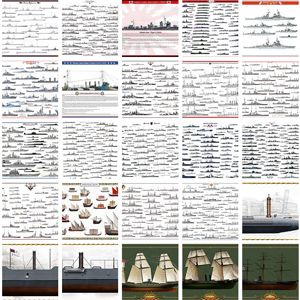
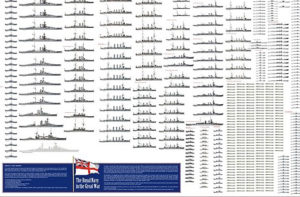
 French Navy
French Navy Royal Navy
Royal Navy Russian Navy
Russian Navy Armada Espanola
Armada Espanola Austrian Navy
Austrian Navy K.u.K. Kriegsmarine
K.u.K. Kriegsmarine Dansk Marine
Dansk Marine Nautiko Hellenon
Nautiko Hellenon Koninklije Marine 1870
Koninklije Marine 1870 Marinha do Brasil
Marinha do Brasil Osmanlı Donanması
Osmanlı Donanması Marina Do Peru
Marina Do Peru Marinha do Portugal
Marinha do Portugal Regia Marina 1870
Regia Marina 1870 Nihhon Kaigun 1870
Nihhon Kaigun 1870 Preußische Marine 1870
Preußische Marine 1870 Russkiy Flot 1870
Russkiy Flot 1870 Svenska marinen
Svenska marinen Søværnet
Søværnet Union Navy
Union Navy Confederate Navy
Confederate Navy Armada de Argentina
Armada de Argentina Imperial Chinese Navy
Imperial Chinese Navy Marinha do Portugal
Marinha do Portugal Mexico
Mexico Kaiserliche Marine
Kaiserliche Marine 1898 US Navy
1898 US Navy Sovietskiy Flot
Sovietskiy Flot Royal Canadian Navy
Royal Canadian Navy Royal Australian Navy
Royal Australian Navy RNZN Fleet
RNZN Fleet Chinese Navy 1937
Chinese Navy 1937 Kriegsmarine
Kriegsmarine Chilean Navy
Chilean Navy Danish Navy
Danish Navy Finnish Navy
Finnish Navy Hellenic Navy
Hellenic Navy Polish Navy
Polish Navy Romanian Navy
Romanian Navy Turkish Navy
Turkish Navy Royal Yugoslav Navy
Royal Yugoslav Navy Royal Thai Navy
Royal Thai Navy Minor Navies
Minor Navies Albania
Albania Austria
Austria Belgium
Belgium Columbia
Columbia Costa Rica
Costa Rica Cuba
Cuba Czechoslovakia
Czechoslovakia Dominican Republic
Dominican Republic Haiti
Haiti Hungary
Hungary Honduras
Honduras Estonia
Estonia Iceland
Iceland Eire
Eire Equador
Equador Iran
Iran Iraq
Iraq Latvia
Latvia Liberia
Liberia Lithuania
Lithuania Mandchukuo
Mandchukuo Morocco
Morocco Nicaragua
Nicaragua Persia
Persia San Salvador
San Salvador Sarawak
Sarawak Uruguay
Uruguay Venezuela
Venezuela Zanzibar
Zanzibar Warsaw Pact Navies
Warsaw Pact Navies Bulgaria
Bulgaria Hungary
Hungary

 Bundesmarine
Bundesmarine Dutch Navy
Dutch Navy Hellenic Navy
Hellenic Navy Marina Militare
Marina Militare Yugoslav Navy
Yugoslav Navy Chinese Navy
Chinese Navy Indian Navy
Indian Navy Indonesian Navy
Indonesian Navy JMSDF
JMSDF North Korean Navy
North Korean Navy Pakistani Navy
Pakistani Navy Philippines Navy
Philippines Navy ROKN
ROKN Rep. of Singapore Navy
Rep. of Singapore Navy Taiwanese Navy
Taiwanese Navy IDF Navy
IDF Navy Saudi Navy
Saudi Navy Royal New Zealand Navy
Royal New Zealand Navy Egyptian Navy
Egyptian Navy South African Navy
South African Navy






























 Ukrainian Navy
Ukrainian Navy dbodesign
dbodesign